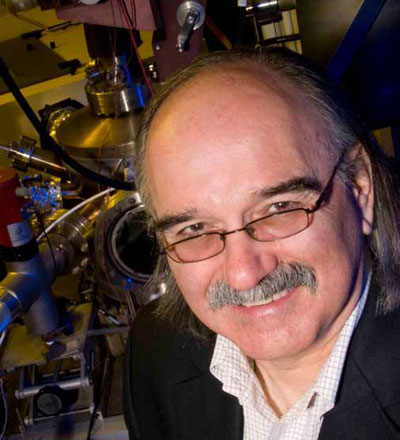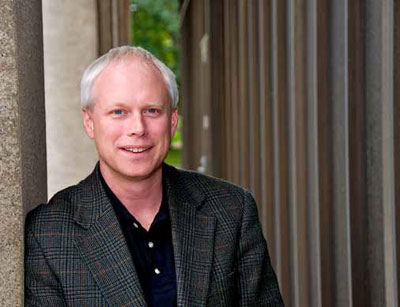the greatest energy in the smallest package
With an Ohio Third Frontier Award and an industry partner, two chemistry professors prepare the way for the next generation of lithium-ion batteries

In his Clapp Hall laboratory, Daniel Scherson takes a "combinatorial approach" to electrochemical research. Among other honors, he was awarded the Faraday Medal of the Electrochemistry Group of the Royal Chemical Society in 2004.
By Trudy E. Bell
"Rechargeable lithium-ion batteries power small devices like computers, cameras and cell phones. Why can't they also be used to power full-sized electric vehicles?" wondered Daniel A. Scherson, Charles F. Mabery Professor of Research in Chemistry.
That deceptively simple question led Scherson and his colleague, chemistry professor John D. Protasiewicz, to join Novolyte Technologies, Inc., in seeking a major grant from the Ohio Third Frontier (OTF) Advanced Energy Program. Earlier this year, the team was awarded more than $1.1 million to develop new electrolytes—mixtures of solvents and salts—for next-generation lithium-ion batteries.
In battery research and development, “everything boils down to how to pack the greatest energy into the smallest package and the smallest weight,” says Scherson, who also directs the Ernest B. Yeager Center for Electrochemical Sciences. The greater the energy density of the battery in an electric car, the farther the car can travel on a single charge. And of all the elements in the periodic table, there is no better choice for energy-dense batteries than lithium.
Still, engineering a battery with sufficient energy density to compete with a tankful of gas is only part of the challenge. "On a freeway, a battery also must be able to accelerate a car from 0 to 60 miles per hour in under half a minute," Scherson explains. Fast acceleration demands a high-power battery that can deliver energy as quickly as an internal combustion engine does.
Finally, battery developers must address a safety issue. When lithium-ion batteries are overcharged, they can heat up and even burst into flame. Scherson and his team hope both to enhance power and to reduce flammability by figuring out the optimum internal chemistry of lithium-ion batteries.
Electro-what?
All batteries convert chemical energy into electrical energy; that is, they initiate chemical reactions that force electrons (negative charges) to flow as current through wires. For this purpose, every battery consists of two electrodes—one negative, one positive—immersed in a conductive medium: an electrolyte.
In a lithium-ion battery, the positive electrode is a solid that includes lithium ions; the negative electrode is made primarily of carbon. A salt dissolved in the electrolyte contains lithium ions as well. While the battery is charging, lithium ions migrate out of the positive electrode into the electrolyte. Meanwhile, lithium ions from the electrolyte migrate into the carbon structure of the negative electrode. As a result, the chemical composition of both electrodes changes—and it stays that way as long as the two electrodes remain disconnected, as they are when a battery-powered device is turned off.
-Daniel Scherson
When the device is switched on, however, the external circuit is completed. Spontaneous chemical reactions cause electrons to flow through this circuit. Inside the battery, meanwhile, lithium ions leave the negative electrode, flow through the electrolyte and return to the positive electrode. By the time the battery has fully discharged, both electrodes have reverted to their original chemical composition.
Surprisingly, the electrolytes in all of today's commercial lithium-ion batteries rely primarily on only two or three salts and solvents. "But many more promising chemicals exist—so many, in fact, that the exact properties of various combinations are not well understood," Scherson says. Electrochemists also want to learn more about a film that forms on the negative electrodes of lithium-ion batteries. This film, called the solid electrolyte interphase (SEI), determines to a large extent how efficient the battery can be over many charge/discharge cycles.
At this point, no chemist or battery manufacturer knows the best and safest electrolyte for a high-energy, high-power, rechargeable lithium-ion battery—especially a larger-format battery that would power an electric car. Moreover, because of the sheer number of combinations of potential salts and solvents and the lack of fundamental knowledge about them, it is impossible to predict what the recipe for an optimal battery electrolyte might be.
Enter Scherson and his team, whose distinctive research approach won them the OTF award.
Lucky Accidents
"Many wonderful inventions we use today were discovered by sheer accident," Scherson observes. "So, in our battery research, why can't we deliberately create the right conditions for a lucky accident?"
To this end, Scherson and his team will borrow a technique widely used in biomedical applications and research on catalysts. Scherson calls it a combinatorial approach and says, “It will allow us to test 10,000 different combinations of solvents and salts in just a few months."
Part of the OTF grant will fund the custom-building of a 10-by-10 array of 100 “cells,” each of which is essentially a small lithium-ion battery. A computer will control syringe-like injectors that will deliver precisely measured amounts of a single solvent and a single lithium salt into each cell. Then, over the next 24 hours, the computer will automatically monitor the behavior of each cell over many charge/discharge cycles. Every 24 hours, all the cells will be flushed and new combinations of solvent and salt will be injected for testing.
"Yes, in a way, it's a fishing expedition," Scherson laughs. "We're dropping lines all over the lake to discover the best spots to fish. We're prospecting!" But with such a systematic and automated empirical approach, the team expects to take less than six months to identify the combinations of solvents and salts that deliver the highest power. They will also take a similar approach to identifying additives that reduce flammability and to studying the chemistry of the SEI.
Novolyte Technologies, based in Independence, Ohio, will provide the chemicals for this research. Novolyte "has the highest-purity salts and solvents of any company in the world," Scherson declares. "They produce 95 percent of the electrolyte formulations for lithium and lithium-ion batteries in the Western world. It was a marriage made in heaven.” Along with its U.S.- and Asia-based manufacturing platforms and global supply relationships with lithium-ion battery manufacturers, Novolyte provides an established channel to commercialize the innovative products born from the OTF-funded research.

John Protasiewicz, professor and associate chair of chemistry, is collaborating with Scherson on the Ohio Third Frontier project. He leads a research group devoted to the construction of novel materials and has received an unbroken string of National Science Foundation grants since 1997, including an NSF CAREER Award and an award for special creativity.
"We are looking forward to working with such a well-known institution of higher learning, and with Dr. Scherson, whose expertise is world renowned in the field of electrochemistry," says Dr. Martin Payne, Novolyte's global technology manager. "The partnership also allows us to accelerate our own program for battery development and commercialization." Ultimately, Payne hopes that the team’s discoveries will help generate high-tech energy jobs in Ohio—the sorts of jobs that might appeal to future Case Western Reserve graduates.
By the conclusion of the OTF grant, Novolyte’s goal is to offer commercial quantities (metric tons) of the newly discovered electrolytes for sale to battery manufacturers. Those firms will use them to build and test prototype lithium-ion batteries suitable for powering electric vehicles.
Scherson acknowledges that converting to plug-in electric cars wouldn’t necessarily reduce overall emissions of carbon and other pollutants. But it would offer one significant advantage: "Pollution and emissions would be localized to individual electric power plants rather than spread all over the nation—and pollution and emissions from one place are far easier to capture and mitigate than generalized sources are." For this reason, Scherson says, "Going to electric vehicles would be a huge service to society."
Science journalist Trudy E. Bell is a Presidential Fellow in the SAGES program, leading the seminar "Political Hype vs. Science Fact: Evidence, Risk, Preferences, Values and 'Spin.'"
